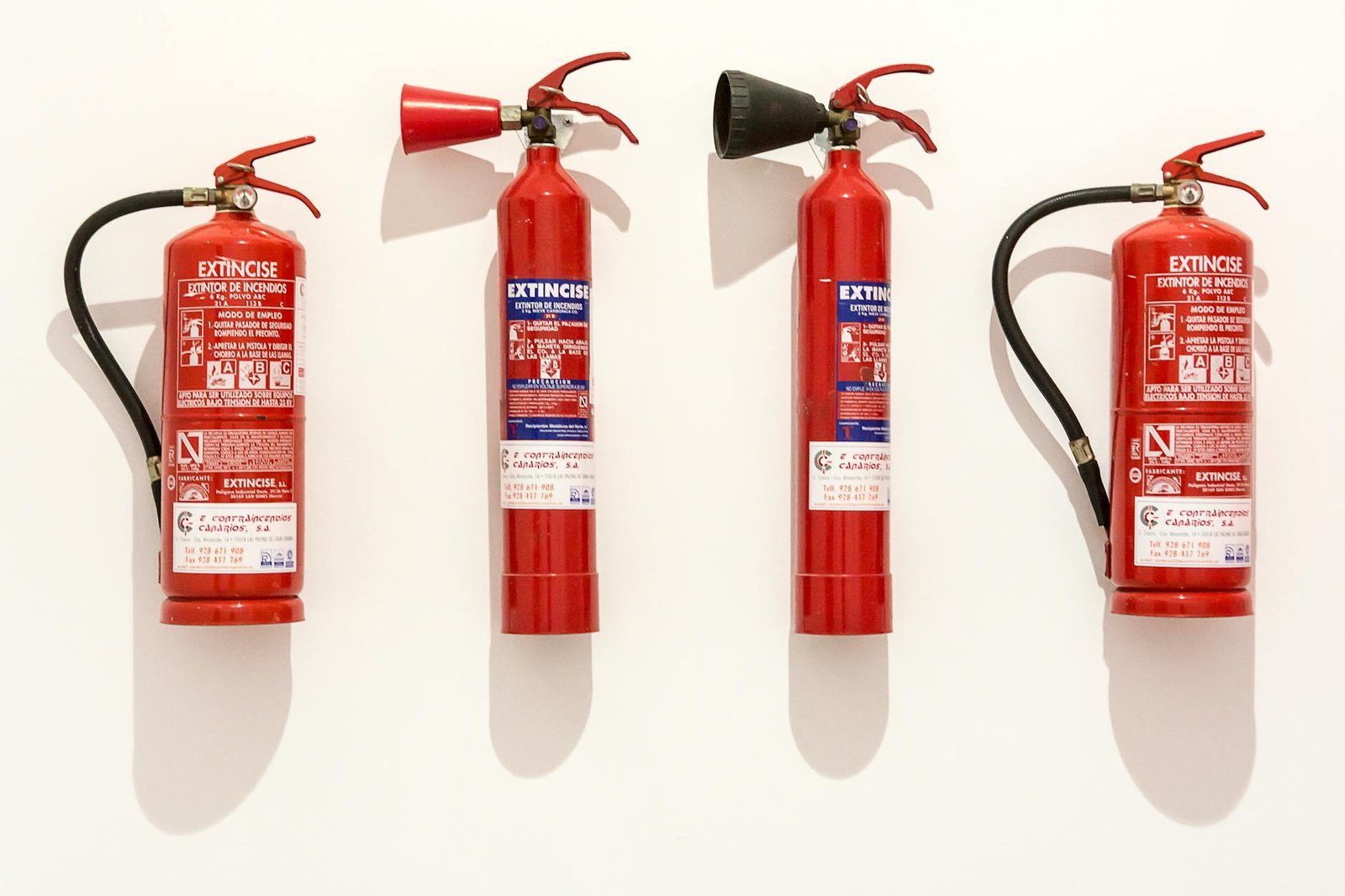
Fire Prevention and Extinguisher Use Quiz
1. What does the “PASS” acronym stand for in fire extinguisher use?
a) Pull, Alert, Squeeze, Sweep
b) Push, Aim, Spray, Stop
c) Pull, Aim, Squeeze, Sweep
d) Press, Align, Shoot, Spread
Answer: c) Pull, Aim, Squeeze, Sweep
Explanation: The PASS technique is the correct method for using a fire extinguisher:
- Pull the pin
- Aim at the base of the fire
- Squeeze the handle
- Sweep side to side
2. Which class of fire involves flammable liquids like gasoline or oil?
a) Class A
b) Class B
c) Class C
d) Class D
Answer: b) Class B
Explanation: Class B fires involve flammable liquids (gasoline, oil, grease).
3. What type of fire extinguisher is best for electrical fires?
a) Water
b) Foam
c) CO₂ (Carbon Dioxide)
d) Wet Chemical
Answer: c) CO₂ (Carbon Dioxide)
Explanation: CO₂ extinguishers are non-conductive and safe for electrical (Class C) fires.
4. Which of the following is NOT a fire prevention measure?
a) Keeping flammable materials away from heat sources
b) Regularly testing smoke alarms
c) Using water on a grease fire
d) Properly storing chemicals
Answer: c) Using water on a grease fire
Explanation: Water spreads grease fires; a Class B extinguisher or smothering is needed.
5. What is the first thing you should do if a fire starts?
a) Grab a fire extinguisher
b) Alert others and evacuate if necessary
c) Try to put it out yourself
d) Hide under a desk
Answer: b) Alert others and evacuate if necessary
Explanation: Safety comes first—sound the alarm and follow evacuation procedures.
6. Which fire extinguisher is suitable for cooking oil fires (Class K)?
a) Dry Chemical
b) Wet Chemical
c) CO₂
d) Water Mist
Answer: b) Wet Chemical
Explanation: Wet chemical extinguishers are designed for kitchen grease fires.
7. What should you do if your clothes catch fire?
a) Run for help
b) Stop, Drop, and Roll
c) Pour water on yourself
d) Remove clothing immediately
Answer: b) Stop, Drop, and Roll
Explanation: This smothers flames and prevents burns.
8. Which class of fire involves combustible metals like magnesium?
a) Class A
b) Class B
c) Class C
d) Class D
Answer: d) Class D
Explanation: Class D fires involve metals (e.g., magnesium, titanium).
9. How often should fire extinguishers be inspected?
a) Every 10 years
b) Monthly (visually) and annually (professionally)
c) Only when used
d) Every 5 years
Answer: b) Monthly (visually) and annually (professionally)
Explanation: OSHA recommends monthly checks and professional servicing yearly.
10. What is the main cause of workplace fires?
a) Arson
b) Electrical faults
c) Smoking
d) Spontaneous combustion
Answer: b) Electrical faults
Explanation: Faulty wiring, overloaded circuits, and equipment malfunctions are leading causes.
11. Which fire extinguisher leaves a residue that requires cleanup?
a) CO₂
b) Dry Chemical
c) Water
d) Clean Agent
Answer: b) Dry Chemical
Explanation: Dry chemical extinguishers leave a powdery residue.
12. What does a red fire extinguisher label typically indicate?
a) Water (Class A)
b) CO₂ (Class B/C)
c) Foam (Class A/B)
d) Wet Chemical (Class K)
Answer: a) Water (Class A)
Explanation: Red-labeled extinguishers usually contain water for Class A fires.
13. When should you fight a fire with an extinguisher?
a) If it’s spreading rapidly
b) If it’s small and contained
c) If smoke fills the room
d) If you’re alone
Answer: b) If it’s small and contained
Explanation: Only attempt to extinguish a fire if it’s small and you have a clear escape route.
14. Which material should NEVER be used on an electrical fire?
a) CO₂
b) Water
c) Dry Chemical
d) Halon
Answer: b) Water
Explanation: Water conducts electricity and can cause shocks or spread the fire.
15. What is the purpose of a fire sprinkler system?
a) To detect smoke
b) To suppress fires automatically
c) To replace fire extinguishers
d) To alert the fire department
Answer: b) To suppress fires automatically
Explanation: Sprinklers activate when heat is detected to control fires.
16. Which of the following is a fire hazard?
a) Storing paper in a cabinet
b) Overloaded power strips
c) Using a metal trash can
d) Having a first aid kit
Answer: b) Overloaded power strips
Explanation: Overloading circuits can cause overheating and fires.
17. What color is a CO₂ fire extinguisher?
a) Red
b) Black
c) Blue
d) Yellow
Answer: b) Black
Explanation: CO₂ extinguishers often have a black label or band.
18. What is the best way to prevent fires in a kitchen?
a) Leaving cooking unattended
b) Keeping flammable items away from the stove
c) Using water on grease fires
d) Storing oil near open flames
Answer: b) Keeping flammable items away from the stove
Explanation: Towels, curtains, and paper near stoves can easily catch fire.
19. Which fire extinguisher is safe for all fire classes (A, B, C)?
a) Water
b) ABC Dry Chemical
c) CO₂
d) Wet Chemical
Answer: b) ABC Dry Chemical
Explanation: ABC extinguishers are multipurpose and work on most common fires.
20. What should you do if a fire extinguisher is empty or damaged?
a) Hide it
b) Report it and replace it immediately
c) Use it anyway
d) Throw it away
Answer: b) Report it and replace it immediately
Explanation: Faulty extinguishers must be replaced to ensure safety.
Workplace Hazard Identification Quiz